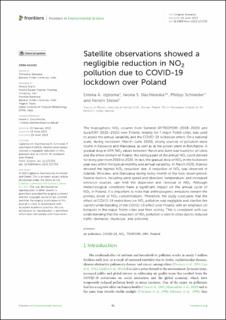| dc.contributor.author | Ugboma, Emeka A. | |
| dc.contributor.author | Stachlewska, Iwona S. | |
| dc.contributor.author | Schneider, Philipp | |
| dc.contributor.author | Stebel, Kerstin | |
| dc.date.accessioned | 2023-07-05T08:45:13Z | |
| dc.date.available | 2023-07-05T08:45:13Z | |
| dc.date.created | 2023-06-28T09:37:26Z | |
| dc.date.issued | 2023 | |
| dc.identifier.citation | Frontiers in Environmental Science. 2023, 11, 1172753. | en_US |
| dc.identifier.issn | 2296-665X | |
| dc.identifier.uri | https://hdl.handle.net/11250/3076020 | |
| dc.description.abstract | The tropospheric NO2 column from Sentinel-5P/TROPOMI (2018–2020) and Aura/OMI (2010–2020) over Poland, notably for 7 major Polish cities, was used to assess the annual variability and the COVID-19 lockdown effect. On a national scale, during lockdown (March–June 2020), strong sources of pollution were found in Katowice and Warszawa, as well as at the power plant in Bełchatów. A gradual drop in OMI NO2 values between March and June was found for all cities and the entire domain of Poland, this being a part of the annual NO2 cycle derived for every year from 2010 to 2020. In fact, the gradual drop of NO2 in the lockdown year was within the typical monthly and annual variability. In March 2020, Kraków showed the highest NO2 reduction rate. A reduction of NO2 was observed in Gdańsk, Wrocław, and Warszawa during every month of the lock-down period. Several factors, including wind speed and direction, temperature, and increased emission sources, can limit the dispersion and removal of NO2. Although meteorological conditions have a significant impact on the annual cycle of NO2 in Poland, it is important to note that anthropogenic emissions remain the primary driver of NO2 concentrations. Therefore, the study concludes that the effect of COVID-19 restrictions on NO2 pollution was negligible and clarifies the current understanding of the COVID-19 effect over Poland, with an emphasis on hotspots in the major Polish cities and their vicinity. This is consistent with our understanding that the reduction of NO2 pollution is seen in cities due to reduced traffic (domestic, municipal, and airborne). | en_US |
| dc.language.iso | eng | en_US |
| dc.rights | Navngivelse 4.0 Internasjonal | * |
| dc.rights.uri | http://creativecommons.org/licenses/by/4.0/deed.no | * |
| dc.title | Satellite observations showed a negligible reduction in NO2 pollution due to COVID-19 lockdown over Poland | en_US |
| dc.title.alternative | Satellite observations showed a negligible reduction in NO2 pollution due to COVID-19 lockdown over Poland | en_US |
| dc.type | Peer reviewed | en_US |
| dc.type | Journal article | en_US |
| dc.description.version | publishedVersion | en_US |
| dc.rights.holder | © 2023 Ugboma, Stachlewska, Schneider and Stebel. | en_US |
| dc.source.volume | 11 | en_US |
| dc.source.journal | Frontiers in Environmental Science | en_US |
| dc.identifier.doi | 10.3389/fenvs.2023.1172753 | |
| dc.identifier.cristin | 2158915 | |
| dc.relation.project | ESA - den europeiske romfartsorganisasjonen: 4000119961/16/NL/FF/mg | en_US |
| dc.relation.project | ESA - den europeiske romfartsorganisasjonen: 4000131513/20/I-DT | en_US |
| dc.relation.project | NILU - Norsk institutt for luftforskning: 120122 | en_US |
| dc.relation.project | NILU - Norsk institutt for luftforskning: 122107 | en_US |
| dc.relation.project | NILU - Norsk institutt for luftforskning: 121004 | en_US |
| dc.source.articlenumber | 1172753 | en_US |
| cristin.ispublished | true | |
| cristin.fulltext | original | |
| cristin.qualitycode | 1 | |

